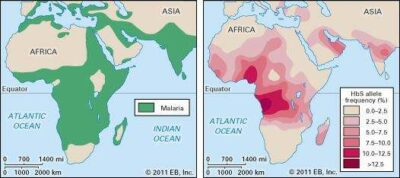
Doesn’t race explain sickle cell. No, evolution explains sickle cell. The map below shows the distribution of sickle cell allele (one copy) and the distribution of malaria. We now know that having a copy of the sickle cell allele is an adaptation that helps resist malaria. Simply, sickle cell allele was selected and increased or evolved in areas where malaria was endemic, and that includes parts of Africa and also parts of the Middle East, the Mediterranean, India and Arabia.
Race is a powerful idea and a worldview that was invented and reified to explain variation in human biology, culture, and behavior (Smedley, 1999). The underpinnings of this idea can be traced to classic Greek philosophical notions of ideal types and Christian ideas about a great chain of being. However, in the view of most historians of race and slavery, the idea of biologically based human races was itself a more recent invention (Smedley, 1999). With the development of ocean travel and international migration, human differences were magnified and the idea of race as biological was made to seem real to justify slavery and colonization. Starting in the eighteenth century, natural historians such as Linnaeus began to classify humans into subspecies or races. These classifications persist today. However, we now know that the idea of biological races as fixed and unchanging types is antithetical to the idea of evolution;The Idea of
What is perhaps most problematic about the idea of race is that it is not a process; rather, it is cast as a thing or an end result of a process. To say that race differences exist because of race is a tautology. There are in these explanations no explicitly theorized arguments relating to the processes by which race differences came into being. Yet we know now that genetic variation arose and is a result of human evolution and history. The idea of race, of stable and unchanging types, inhibits rather than advances studies of the evolution of human differences.




